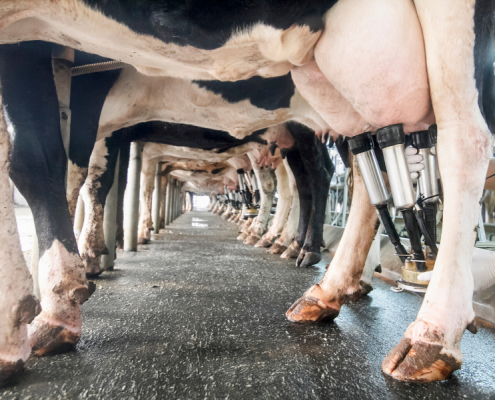Balanced concentrate feeding with good levels of dietary fibre from sources such as soya hulls, sugar beet pulp or high-fibre moist feeds.
Preventing milk fat depression this summer
Maintaining milk butterfat levels through the spring and summer grazing season is an annual challenge for dairy units across the UK (Figure 1) and Ireland.
Yet with the right adjustments to buffer feeding, it’s possible to reduce the impact and protect valuable butterfats, claims Kayley Barnes, AB Vista’s GB&I Ruminant and Equine Technical Manager.

Figure 1: Average UK milk butterfat content in 2018-19 and 2019-20. (DEFRA)
Figure 2: Average analysis from multiple samples of April 2020 fresh grass taken using AB Vista’s portable NIR 4 Farm device

“The main component in milk butterfat production is the volatile fatty acid ‘acetate’, which is produced when dietary fibre is fermented in the rumen,” she explains. “The problem is that although young spring grass provides a great source of both energy – in the form of rapidly fermentable carbohydrates or sugars – and protein, it’s structurally immature (Figure 2).
“As a result, fibre levels are extremely low compared with older, more mature grass. This limits the amount of acetate produced in the rumen, which in turn reduces milk butterfat levels.”
The positive impact of stabilising rumen pH
Good rumen function is also critical, with fibre digestion in the rumen impaired whenever rumen pH drops below 5.8. This not only further cuts acetate and milk butterfat production, but can reduce feed intakes, overall nutrient supply and milk yield, as well as increasing the incidence of health problems such as laminitis.
“The high levels of rapidly fermentable carbohydrates and sugars in spring grass, combined with low levels of structural fibre, can result in extended periods of low rumen pH,” Ms Barnes continues. “If the rumen drops below pH 5.8 – the threshold for sub-acute rumen acidosis or SARA – the impact is even greater.”
Low milk butterfat is an indicator for SARA at any time of the year, but in the spring, when butterfats are already depressed, it can be harder to spot.
“One of the best ways to reduce the rate and extent of any rumen pH drop is to add
Ration tips to boost acetate production and milk butterfat:
- dietary fibre
- concentrate
Feed a concentrate that compliments the energy coming from lush grass combined with feeding a long fibre (hay or straw) to stimulate cudding and help release acid-neutralising saliva.
- condition the rumen
Add
CalMinProMinAcid Bufslow release rumen conditioner and Vistacell live yeast to stabilise rumen pH, minimising the time spent in acidic conditions (below pH 5.8) when fibre digestion is compromised.
Increasing butterfats with live yeast and conditioners
In a 2014 trial, the addition of
“The trial results highlight the value of properly supporting rumen function and fibre digestion when looking to maintain butterfat production when grazing,” Ms Barnes concludes.
“Whether used individually or together, the addition of
![[geot country="US"] CalMin[/geot][geot country="CA"] ProMin[/geot][geot exclude_country="CA, US"] Acid Buf[/geot] optimises rumen pH [geot country="US"] CalMin[/geot][geot country="CA"] ProMin[/geot][geot exclude_country="CA, US"] Acid Buf[/geot] optimises rumen pH](https://celticseaminerals.com/wp-content/uploads/2020/06/ABV-Schothorst-pH.png)
Figure 3: Effect of CalMin ProMin Acid Buf and Vistacell use on rumen pH versus control (Source: Schothorst Feed Research, 2014)
Benefits & Conclusions
Maintaining butterfat levels at turnout can be challenging due to the reduced fibre content of the lush grass. The inclusion of
![[geot country="US"] CalMin[/geot][geot country="CA"] ProMin[/geot][geot exclude_country="CA, US"] Acid Buf[/geot] rumen buffer reduces the risk for milk butterfat depression during the summer grazing season. [geot country="US"] CalMin[/geot][geot country="CA"] ProMin[/geot][geot exclude_country="CA, US"] Acid Buf[/geot] rumen buffer reduces the risk for milk butterfat depression during the summer grazing season.](https://celticseaminerals.com/wp-content/uploads/2020/06/ABV-Milk-butterfat-science.png.jpg)
The efficacy of CalMin ProMin Acid Buf is supported by independent peer reviewed research
- buffers the rumen
Buffers the rumen for a minimum of 8 hours – minimising the time spent below pH 5.8.
- improves feed efficiency
Improves feed conversion efficiency (FCE) – more production from the ration.
- saves space in a diet
Can be offered at relatively low feed rates – freeing up dietary space.
- bioavailable minerals for the rumen
Contains a source of highly bioavailable magnesium and calcium – helping restore cow magnesium levels, reduce incidence of grass tetany (staggers) and improve butterfat levels.
- increases milk butter fat and milk protein
Further background information is given in the technical article “How to increase milk butterfat?”
This article was published by British Dairying I Editor Kayley Barnes, Technical Manager AB Vista I May Edition 2020, pages 40-41

Related articles
 https://celticseaminerals.com/wp-content/uploads/2021/02/Transition-cow-Acid-Buf-CSM-800x600-1.png
600
800
Patricia
https://celticseaminerals.com/wp-content/uploads/2020/01/Celtic_13.png
Patricia2021-02-08 15:05:032023-03-02 13:35:35Transition Cow Management
https://celticseaminerals.com/wp-content/uploads/2021/02/Transition-cow-Acid-Buf-CSM-800x600-1.png
600
800
Patricia
https://celticseaminerals.com/wp-content/uploads/2020/01/Celtic_13.png
Patricia2021-02-08 15:05:032023-03-02 13:35:35Transition Cow Management https://celticseaminerals.com/wp-content/uploads/2020/11/CSM-CeltiMin-layers-featured-image-webpage-800x600-1.png
600
800
Patricia
https://celticseaminerals.com/wp-content/uploads/2020/01/Celtic_13.png
Patricia2020-11-03 15:41:302023-03-02 13:36:21How to prevent eggshell quality problems?
https://celticseaminerals.com/wp-content/uploads/2020/11/CSM-CeltiMin-layers-featured-image-webpage-800x600-1.png
600
800
Patricia
https://celticseaminerals.com/wp-content/uploads/2020/01/Celtic_13.png
Patricia2020-11-03 15:41:302023-03-02 13:36:21How to prevent eggshell quality problems? https://celticseaminerals.com/wp-content/uploads/2020/09/CSM-featured-image-gastric-pH-800x600px.png
600
800
Patricia
https://celticseaminerals.com/wp-content/uploads/2020/01/Celtic_13.png
Patricia2020-09-20 15:10:092023-03-02 13:36:48How gastric pH affects pig gut health
https://celticseaminerals.com/wp-content/uploads/2020/09/CSM-featured-image-gastric-pH-800x600px.png
600
800
Patricia
https://celticseaminerals.com/wp-content/uploads/2020/01/Celtic_13.png
Patricia2020-09-20 15:10:092023-03-02 13:36:48How gastric pH affects pig gut health https://celticseaminerals.com/wp-content/uploads/2020/07/CSM-featured-image-heat-stress-asia.png
600
800
Patricia
https://celticseaminerals.com/wp-content/uploads/2020/01/Celtic_13.png
Patricia2020-07-28 08:45:572023-03-02 13:38:15Heat stress in dairy cows
https://celticseaminerals.com/wp-content/uploads/2020/07/CSM-featured-image-heat-stress-asia.png
600
800
Patricia
https://celticseaminerals.com/wp-content/uploads/2020/01/Celtic_13.png
Patricia2020-07-28 08:45:572023-03-02 13:38:15Heat stress in dairy cows https://celticseaminerals.com/wp-content/uploads/2020/06/CSM-featured-image-feed-efficiency-800x600px.png
600
800
Patricia
https://celticseaminerals.com/wp-content/uploads/2020/01/Celtic_13.png
Patricia2020-06-30 12:28:302023-03-02 13:39:19Improving feed efficiency in dairy cows
https://celticseaminerals.com/wp-content/uploads/2020/06/CSM-featured-image-feed-efficiency-800x600px.png
600
800
Patricia
https://celticseaminerals.com/wp-content/uploads/2020/01/Celtic_13.png
Patricia2020-06-30 12:28:302023-03-02 13:39:19Improving feed efficiency in dairy cows https://celticseaminerals.com/wp-content/uploads/2020/06/CSM-featured-image-piglets-sleeping-800x600px.png
600
800
Patricia
https://celticseaminerals.com/wp-content/uploads/2020/01/Celtic_13.png
Patricia2020-06-23 15:33:152023-03-02 13:40:54How to reduce pig aggression?
https://celticseaminerals.com/wp-content/uploads/2020/06/CSM-featured-image-piglets-sleeping-800x600px.png
600
800
Patricia
https://celticseaminerals.com/wp-content/uploads/2020/01/Celtic_13.png
Patricia2020-06-23 15:33:152023-03-02 13:40:54How to reduce pig aggression? https://celticseaminerals.com/wp-content/uploads/2020/06/CSM-featured-image-beef-cattle-charolais-800x600px.png
600
800
Patricia
https://celticseaminerals.com/wp-content/uploads/2020/01/Celtic_13.png
Patricia2020-06-16 07:25:322023-03-02 13:41:17Fiber digestion drives beef cattle performance
https://celticseaminerals.com/wp-content/uploads/2020/06/CSM-featured-image-beef-cattle-charolais-800x600px.png
600
800
Patricia
https://celticseaminerals.com/wp-content/uploads/2020/01/Celtic_13.png
Patricia2020-06-16 07:25:322023-03-02 13:41:17Fiber digestion drives beef cattle performance Celtic Sea Minerals
https://celticseaminerals.com/wp-content/uploads/2020/06/CSM-featured-image-dairy-cow-neville-800x600px.png
600
800
Patricia
https://celticseaminerals.com/wp-content/uploads/2020/01/Celtic_13.png
Patricia2020-06-01 20:53:282023-03-02 13:44:46How a rumen buffer drives dairy performance
Celtic Sea Minerals
https://celticseaminerals.com/wp-content/uploads/2020/06/CSM-featured-image-dairy-cow-neville-800x600px.png
600
800
Patricia
https://celticseaminerals.com/wp-content/uploads/2020/01/Celtic_13.png
Patricia2020-06-01 20:53:282023-03-02 13:44:46How a rumen buffer drives dairy performance https://celticseaminerals.com/wp-content/uploads/2020/05/CSM-featured-image-holstein-cow-gras-800x600px.png
600
800
Patricia
https://celticseaminerals.com/wp-content/uploads/2020/01/Celtic_13.png
Patricia2020-05-24 21:54:212023-03-02 13:45:11How to reduce the risk for grass staggers?
https://celticseaminerals.com/wp-content/uploads/2020/05/CSM-featured-image-holstein-cow-gras-800x600px.png
600
800
Patricia
https://celticseaminerals.com/wp-content/uploads/2020/01/Celtic_13.png
Patricia2020-05-24 21:54:212023-03-02 13:45:11How to reduce the risk for grass staggers? https://celticseaminerals.com/wp-content/uploads/2020/05/CSM-featured-image-pig-nose-800x600px.png
600
800
Patricia
https://celticseaminerals.com/wp-content/uploads/2020/01/Celtic_13.png
Patricia2020-05-12 22:21:192023-03-02 13:46:30How to prevent gastric ulcers in pigs?
https://celticseaminerals.com/wp-content/uploads/2020/05/CSM-featured-image-pig-nose-800x600px.png
600
800
Patricia
https://celticseaminerals.com/wp-content/uploads/2020/01/Celtic_13.png
Patricia2020-05-12 22:21:192023-03-02 13:46:30How to prevent gastric ulcers in pigs? Celtic Sea Minerals
https://celticseaminerals.com/wp-content/uploads/2020/04/CSM-Iceland-Marine-Minerals.png
600
800
Patricia
https://celticseaminerals.com/wp-content/uploads/2020/01/Celtic_13.png
Patricia2020-04-20 07:15:212023-03-02 13:48:33Marine Minerals Nutrition Platform
Celtic Sea Minerals
https://celticseaminerals.com/wp-content/uploads/2020/04/CSM-Iceland-Marine-Minerals.png
600
800
Patricia
https://celticseaminerals.com/wp-content/uploads/2020/01/Celtic_13.png
Patricia2020-04-20 07:15:212023-03-02 13:48:33Marine Minerals Nutrition Platform Celtic Sea Minerals
https://celticseaminerals.com/wp-content/uploads/2020/04/CSM-dairy-cow-udder-milk-fat.png
600
800
Patricia
https://celticseaminerals.com/wp-content/uploads/2020/01/Celtic_13.png
Patricia2020-04-19 18:50:522023-03-02 13:47:30How to increase butterfat in dairy cows?
Celtic Sea Minerals
https://celticseaminerals.com/wp-content/uploads/2020/04/CSM-dairy-cow-udder-milk-fat.png
600
800
Patricia
https://celticseaminerals.com/wp-content/uploads/2020/01/Celtic_13.png
Patricia2020-04-19 18:50:522023-03-02 13:47:30How to increase butterfat in dairy cows? Celtic Sea Minerals
https://celticseaminerals.com/wp-content/uploads/2020/02/koe2.jpg
600
800
Patricia
https://celticseaminerals.com/wp-content/uploads/2020/01/Celtic_13.png
Patricia2020-02-14 21:43:062023-03-02 13:47:50How to prevent rumen acidosis?
Celtic Sea Minerals
https://celticseaminerals.com/wp-content/uploads/2020/02/koe2.jpg
600
800
Patricia
https://celticseaminerals.com/wp-content/uploads/2020/01/Celtic_13.png
Patricia2020-02-14 21:43:062023-03-02 13:47:50How to prevent rumen acidosis?You want to get powered by our science?

Strand Farm
Curraghbinny
Carrigaline
Co.Cork
P43 NN62, Ireland
T: +353 21 437 8377
E: info@celticseaminerals.com
Our marine minerals are fully compliant with the following globally recognised quality assurance schemes:


![[geot country="US"] CalMin[/geot][geot country="CA"] ProMin[/geot][geot exclude_country="CA, US"] Acid Buf[/geot] prevents milk fat depression [geot country="US"] CalMin[/geot][geot country="CA"] ProMin[/geot][geot exclude_country="CA, US"] Acid Buf[/geot] prevents milk fat depression](https://celticseaminerals.com/wp-content/uploads/2020/06/CSM-banner-cow-pasture-grass-1600x471px-1500x430.png)
